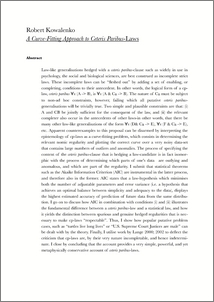Kowalenko, Robert
(2007)
A Curve-Fitting Approach to Ceteris Paribus-Laws.
In: UNSPECIFIED.
![[img]](https://philsci-archive.pitt.edu/style/images/fileicons/application_pdf.png)  Preview |
|
PDF
Kowalenko_(2007)_'A_Curve-Fitting_Approach_to_Ceteris_Paribus-Laws'.pdf
Download (291kB)
|
Abstract
Law-like generalisations hedged with a ceteris paribus-clause such as widely in use in psychology, the social and biological sciences, are best construed as incomplete strict laws. These incomplete laws can be “fleshed out” by adding a set of enabling, or completing, conditions to their antecedent. In other words, the logical form of a cp-law, ceteris paribus (A -> B), is (A & C -> B). The nature of C must be subject to non-ad hoc constraints, however, failing which all putative ceteris paribus-generalisations will be trivially true. Two simple and plausible constraints are that: (i) A and CB be jointly sufficient for the consequent of the law, and (ii) the relevant completer also occur in the antecedents of other laws-in other words, that there be many other law-like generalisations of the form (D & C -> E), (F & C -> E), etc. Apparent counterexamples to this proposal can be disarmed by interpreting the epistemology of cp-laws as a curve-fitting problem, which consists in determining the relevant nomic regularity and plotting the correct curve over a very noisy data-set that contains large numbers of outliers and anomalies. The process of specifiying the content of the ceteris paribus-clause that is hedging a law-candidate is in fact isomorphic with the process of determining which parts of one's data are outlying and anomalous, and which are part of the regularity. I submit that statistical theorems such as the Akaike Information Criterion (AIC) are instrumental in the latter process, and therefore also in the former. AIC states that a law-hypothesis which minimizes both the number of adjustable parameters and error variance (i.e. a hypothesis that achieves an optimal balance between simplicity and adequacy to the data), displays the highest estimated accuracy of prediction of future data from the same distribution. I go on to discuss how AIC in combination with conditions (i) and (ii) illustrates the fundamental difference between a ceteris paribus-law and a statistical law, and how it yields the distinction between spurious and genuine hedged regularities that is necessary to make cp-laws “respectable”. Thus, I show how popular putative problem cases, such as “turtles live long lives”, can be dealt with by the theory. Finally, I utilise work by Lange (2000, 2002) to deflect the criticism that cp-laws are, by their very nature incompletable, and hence indeterminate. I conclude that the curve-fitting approach provides a very simple, powerful, and yet metaphysically conservative account of ceteris paribus-laws.
Monthly Views for the past 3 years
Monthly Downloads for the past 3 years
Plum Analytics
Actions (login required)
 |
View Item |



